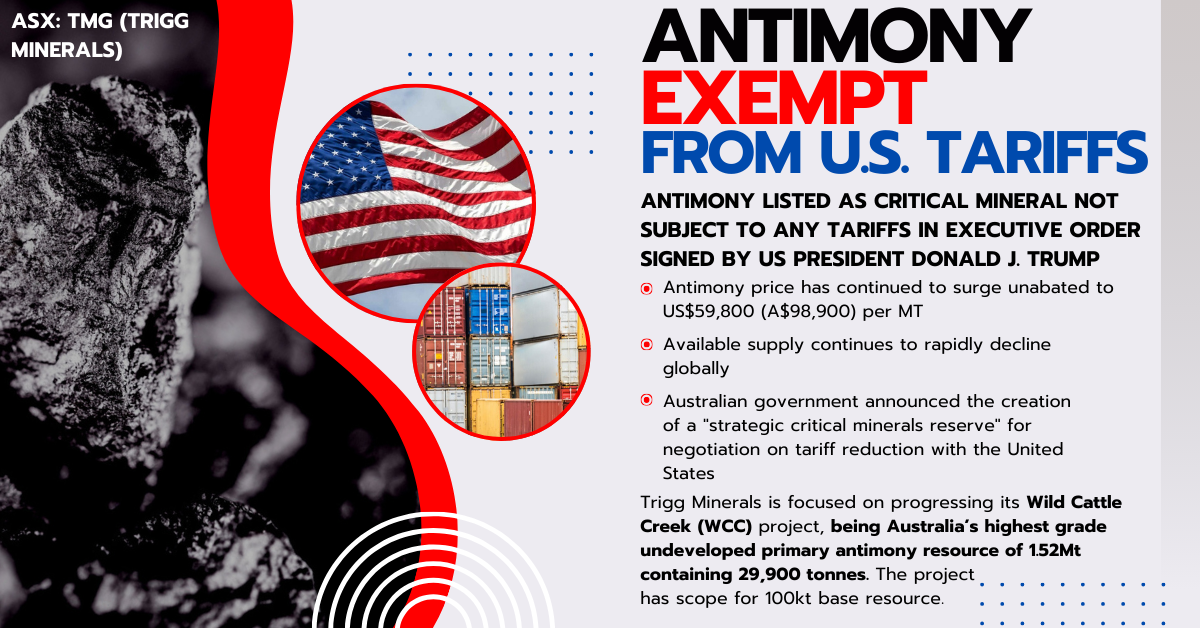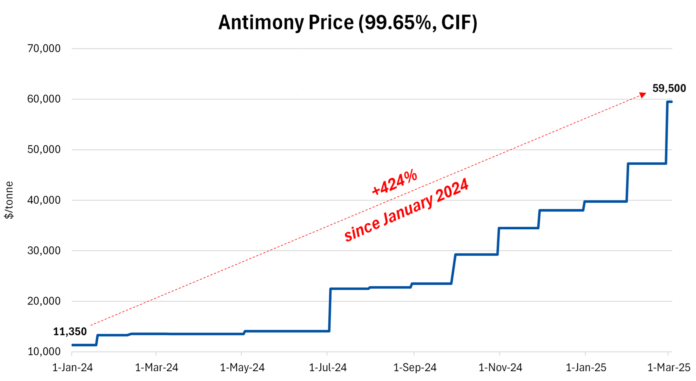by admin
Share
by admin
Share

On 2 April 2025, United States President Donald J. Trump announced the introduction of “reciprocal tariffs” on all of the country’s trading partners. Implemented via executive order, the tariffs came into effect on 5 April 2025. The move triggered sell-offs in equity markets worldwide, as investors repositioned and adjusted to the new normal.
However, antimony—designated as a critical mineral—was exempt from the measures.
Antimony also exempt from new US tariffs
Antimony is classified as a critical raw material by the US, as well as multiple other regions, including Europe, Canada, Australia, India and China.
It was not included in previous US tariff rounds and has once again been exempted from the latest tariffs announced on Wednesday — a decision widely anticipated by market participants.
“It’s not surprising that antimony is exempt, given how heavily reliant the US is on imports. There is no domestic production, and it’s an important metal for their industry and military,” an antimony trader said.
Source: Fastmarkets
This exemption aligns with the U.S. Geological Survey’s 2022 Critical Minerals List, highlighting a clear and coordinated policy stance by the U.S. government that recognises antimony’s strategic significance to both national and global security. The United States—along with other Western nations—remains heavily reliant on imported antimony, with around 94% of global supply controlled by China, Russia, Tajikistan, and Myanmar.

Antimony price has surged to US$59,800 (A$98,900) per mt due to dwindling supply internationally
Antimony has numerous critical-strategic applications, that makes supply critical to national security concerns:
- Hardeners for lead ammunition
- Armour-piercing ammunition
- Tracer ammunition
- NATO ball Ammunition
- Precision optics
- Night vision technology
- Infra-red sensing technology
- Laser sighting flares
- Nuclear weapons
- Military clothing
- Radar deflecting materials
- Communication systems
In addition to other non-military applications, such as:
- Flame retardation
- Plastics
- Rubber
- Paints
- Paper
- Textiles
- Electronics
- Batteries/Energy storage
- Preventing thermal runaway in batteries
- Antimony batteries have twice the lifespan of Lithium batteries
- Glass and solar cells
- Advantages in efficiency and performance
- Excellent light absorption and emission properties
Due to declining local supply and critical applications, China banned the export of Antimony ore and products on September 15, 2024.
Opportunity for Australia
Australia has not been exempt from the tariffs imposed by U.S. President Donald J. Trump, despite the Australia–United States Free Trade Agreement (AUSFTA) remaining in place. Australian exports to the United States are now subject to a flat 10% tariff, with the exception of antimony and other designated critical minerals.
In response, the Australian Government is considering the establishment of a national strategic minerals reserve, intended to serve as a bargaining chip in negotiations aimed at securing an exemption from the tariffs.

Source: ABC (AU)
On 26 February 2025, the United States signed an agreement with Ukraine to jointly develop critical minerals and rare earths within Ukrainian territory. This move reflects a broader strategic shift, as the U.S. seeks to reduce its reliance on China—which has halted exports of critical minerals and rare earths amid the ongoing tariff war.
Trigg Minerals holds a resource of 29,900 tonnes of contained antimony at a grade of 1.97% Sb at its Wild Cattle Creek project in northern New South Wales. The company believes that, with further exploration, the resource has the potential to expand to 100,000 tonnes of contained antimony.
Wild Cattle Creek is currently the highest-grade undeveloped antimony project in Australia.
In the context of the Australian Government’s Critical Minerals Strategy, the project presents a compelling opportunity to help meet the United States’ growing demand for antimony.

